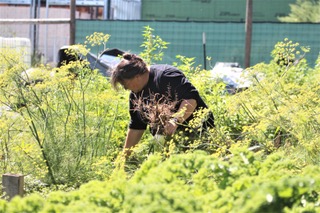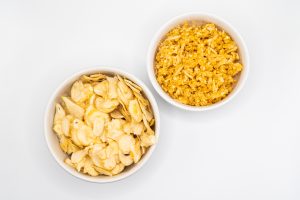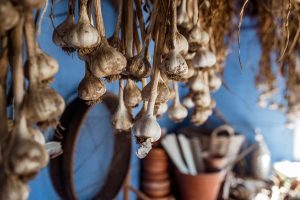Dragonfly Hill Farm uses sustainable organic farming practices. We believe in working with nature rather than forcing it. Organic farming is all about taking care of the soil, which is one giant living organism!
We take measures to prevent pests and diseases in the soil to ensure the plants we grow are healthy and nutrient-dense. We are even working toward our USDA Organic Certification, which calls for many specific practices and qualifications.
It’s easy enough to talk the talk. But how do we walk the walk? That’s why I want to tell you a bit about how we farm. So much work, care, and love goes into growing our delicious garlic.
6 Ways We Care for the Soil & Grow Clean Food
Naturally Grown Using Organic Methods
Toxic chemicals have no place in healthy food. One of the pillars of organic farming is all-natural, chemical-free growing practices. We use:
- NO genetically modified seeds
- NO synthetic pesticides or fertilizers
- NO herbicides
If it’s something you wouldn’t want in or on your body, we don’t use it in our soil or on our plants! We stick to organic methods even when they require more testing, work, and patience.
For example, we have been trying different weed prevention methods. We used straw in our first year, but still ended up weeding too much. Garlic does not do well with weeds! So this year, we’ll combine three techniques:
- Reusable weed barrier fabric: We’ll combine weed barrier fabric with straw on our garlic crops. Hopefully, this will block weeds and stop them from getting a firm hold in the soil. For our winter squash, we will be transplanting seedlings instead of direct-seeding (i.e., sowing the seeds directly in the ground) and using barrier fabric.
- Cover crops: We love cereal rye for weed suppression. It provides a habitat for more healthy microorganisms!
- Silage tarps: Silage tarps are placed over fields or garden beds to kill weeds. We’ll use them before planting and after harvest.
There are also natural ways to get rid of pests, especially for cash crops like our butternut squash. We will use netting after transplanting the squash this year. We can also use organic products like:
- Neem oil
- Liquid soap mixture
- Coffee mixture
- Companion plants (e.g., borage, nasturtiums, and marigolds)
Garlic is largely pest-resistant. The goal is to be prepared when pests arrive. Every farmer should walk their garden daily, observe how each crop is doing, and note any evident pests or bugs. Of course, not all bugs are pests–some are beneficial to our plants.
Weeds and bugs are a part of life, but we’re trying different natural methods that allow us to work smarter, not harder. We are always learning, which is our favorite part of farming!
Natural Soil Amendments
A soil amendment is something added to the soil, usually done to improve the land. Soil amendments can help with things like water retention and aeration. Basically, they help create a healthier environment for roots to thrive.
Dragonfly Hill uses powerful organic materials like compost in our crops. We currently use organic aeromaster humus compost to give our new soil some necessary nutrients. In the fall, we will use a blend of manure compost and chopped leaves.
These materials boost microscopic biodiversity in the soil by creating the perfect home for important microorganisms like healthy bacteria and fungi to thrive.
The healthier the soil, the better the plants will grow, the more carbon will be captured, and the more nutrients and water retained. At the end of the day, nutrient-rich soil helps us grow hearty crops more resistant to insects and diseases.
Low-till
The less soil disturbance, the better! Our goal is to create a permanent bed system for every section in our garden. Once we establish this, we will ONLY till the top few inches of each bed. This leaves the rest of the soil intact. This helps maintain the natural structure of the topsoil, which ensures water retention and makes it easier for new plants to take root. More importantly, minimal tilling helps preserve a habitat for microorganisms, mycorrhizal fungi, and earthworms. It also preserves the soil structure and minimizes erosion.
After the initial tilling to create beds, I add amendments to the established beds every year to replenish their nutrients and the soil’s physical properties. The low-till method has enormous advantages when compared to the constant use of the full-till method.
Cover Crops
Cover crops (e.g., rye, peas, wheat, barley, and oats) are nature’s one-size-fits-all solution for:
- Reducing soil erosion
- Improving soil health
- Enhancing water retention
- Preventing weeds
- Controlling pests and diseases
- Boosting biodiversity
Additionally, cover crops increase crop yields and attract our pollinator friends like bees, bats, and butterflies. They have even been shown to increase resilience to heavy rainfall and drought conditions. It’s no wonder they are a critical organic farming practice!
Crop Rotation
Dragonfly Hill also practices crop rotation, which goes hand-in-hand with cover crops. Crop rotation involves planting different crops sequentially on the same plot of land. This is another method that contributes to soil health.
Planting the same crop in the same spot every year can deplete the soil. Crop rotation gives plants what they need naturally, helping to provide proper nutrition and reduce diseases and pests. Not to mention, it improves soil structure and prevents erosion from water and wind.
Each plant has distinct nutritional needs. Take garlic, which needs a lot of nitrogen to grow. If you plant the same garlic in the same spot every year, the soil would become nitrogen deficient. Sure, you can add synthetic nitrogen back in–but why not do it naturally by planting a cover crop of nitrogen-fixing plants?
For example, we use a six-year crop rotation for garlic and squash crops. All of our other crops have a three-year rotation. If we double our garlic planting in the future, we would switch to a three-year rotation.
Companion Planting
Companion planting means growing different plants together. Certain plants compliment each other. They might require different nutrients to take from the soil holistically. One may grow tall, shading the other underneath. Or one may provide pest repellent qualities for the other. This old practice was used by Native Americans, who often used a trio of maize, climbing beans, and winter squash!
So, why companion planting? Certain crops protect others by:
- Repelling harmful bugs and other critters
- Attracting beneficial insects
- Providing shade for smaller plants
- Protecting low-growing, sprawling crops (e.g., corn supporting cucumbers)
- Improving the health of other plants by absorbing or renewing soil substances
- Preventing weeds
On our farm, we use chamomile, yarrow, and rue because they add to the health and flavor of the garlic. If we pay attention, we can benefit significantly from companion planting.
3 Beginner Ways to Become a Steward of the Land
I also hope to inspire and guide those interested in growing their own wholesome, nutritious food. No matter where you live or what kind of space you have, there are many ways you can grow clean food while acting as a steward of the land. Try:
- Creating a small garden plot: If you want to start something in your backyard, carve out a small plot and start with a couple of easy vegetables. You could also try raised garden beds, which you could purchase or build yourself.
- Starting with garden pots: Try one or two garden pots if you have more limited space and want to start small. Or, you could start with a small herb garden grown in pots—they’re easy to care for, can be dehydrated, and pair well with garlic! Even city dwellers with a small balcony or outdoor space can manage a couple of potted plants.
- Volunteering at a community garden: Many areas have community gardens, which are a great way to learn about gardening and responsible food practices. Plus, it’s a great way to get involved and meet others in your community!
From growing some of your own food to sourcing the rest from local organic farmers you trust, there are plenty of opportunities for everyone to lead a clean, healthy diet and lifestyle. Not to mention, you’ll be helping to support the environment and local economy. And it all starts with respecting the land!
Interested in tasting the goodness of clean, organic food raised with sustainable practices? Try our dried garlic products today, and be sure to let me know what you think!



